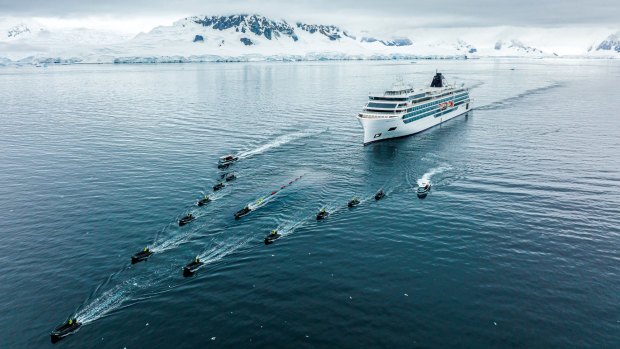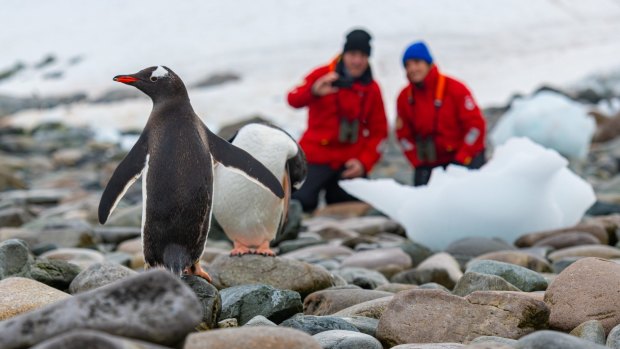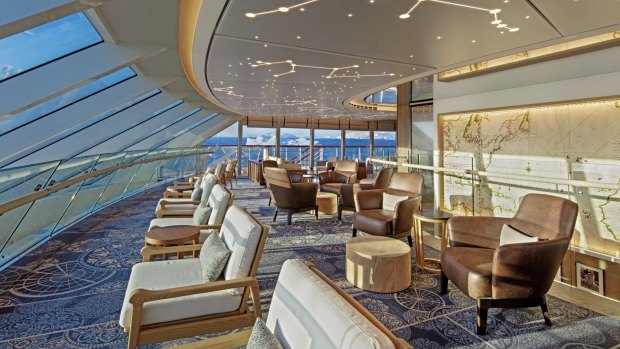This was published 1 year ago
Viking Polaris Antarctic cruise: The luxury cruise ship that doubles as a science vessel

Viking Polaris and Octantis feature 189 luxurious staterooms, each ship carries a submarine (yellow, naturally), onboard research labs, Special Operations Boats built to military specs and the best expedition equipment that money can buy.
I never enjoyed science classes at school, couldn't understand the point of Bunsen burners and looking at boring rocks under a microscope when there was a rich world of literature to explore.
Yet here I am in Antarctica onboard the brand-new Viking Polaris, rushing back from a penguin colony visit to an ornithology lecture, happily risking frostnip to watch the release of a weather balloon and tracking whales with the sort of laser focus I normally apply to tracking down online shopping bargains.
Buoyed by the idea that the research we participate in on this 11-night cruise will contribute real data to real scientific discoveries - could possibly even inform the way people look at and understand the world - I am a citizen scientist convert. It is as thrilling as it is surprising to me, and it's all part of Viking Cruises founder Torstein Hagen's plan.

Meeting the curious locals.
Viking's river and ocean cruises minus casinos, kids and butlers have always focused on cultural enrichment and learning, albeit on beautiful ships with all the luxury comforts. With the inaugural season of Viking Expeditions to Antarctica and the Great Lakes of the United States, there's an even sharper focus.
From a family of modest means in Norway, Hagen's early wanderlust had to be satisfied by airmailed exchanges with penpals. What he wanted most of all was a stamp from the end of the world. In 1957, the 14-year-old Hagen devised a clever plan, writing to his sister at a fictional address in Ushuaia, Argentina, the gateway to Antarctica. Unable to locate the addressee, the post office returned the registered letter, stamped in that faraway land, to sender. Hagen has been fascinated by Antarctica ever since.
Today, the 80-year-old billionaire founder and chairman of Viking Cruises has a new dream: To put scientific exploration and discovery at the heart of cruising to Antarctica and the Great Lakes. A physicist by training and a scientist by self-identification, Hagen handpicked a team of the experts to bring his dream to life, in partnership with a constellation of world-class science organisations including University of Cambridge and Scott Polar Research Institute.

Viking's fleet consists of beautiful ships with all the luxury comforts.
Two new purpose-built ships, Viking Polaris and Octantis, are up to the challenge. In addition to 189 luxurious staterooms, each ship carries a submarine (yellow, naturally), onboard research labs, Special Operations Boats built to military specs and the best expedition equipment that money can buy.
The hardware is essential, but it's the human resources - senior scientists in fields as diverse as glaciology, whale genetics, volcanology and oceanography - that bring hundreds of combined years of scientific knowledge onboard. Lectures in the Aula, the panoramic state-of-the-art auditorium, are so well-attended it's sometimes a challenge to find two empty seats together. One presentation on whales is repeatedly interrupted by actual whales cavorting in the waters surrounding the ship.
In between dips in the pool, Nordic spa treatments and lobster dinners, guests are encouraged to ask countless questions and to get their hands dirty, if they wish, collecting plankton from the sea or mashing up bait in the lab. While some are content with Zodiac rides to shore and close encounters with curious penguins (we see thousands), many relish the opportunity to learn even more about the natural world in the most spectacularly pristine location imaginable.
"We want to totally transform marine science," says Dr Damon Stanwell-Smith, Head of Science & Sustainability for Viking Expeditions. "We have the ability to do world-class research on our ships."
The former executive director of International Association of Antarctic Tour Operators, Stanwell-Smith is a marine scientist who has conducted research for the British Antarctic Survey, as well as the NGO sector and the United Nations. He knows just how important institutional partnerships are to Viking's success in making an impact.
When Viking ships send weather balloons to the stratosphere for the US National Weather Service, they are the first civilian vessels in the world to be harnessed in this way. Balloons are released simultaneously from hundreds of locations worldwide, gathering data that is used for research and next-day weather forecasts from Sydney to Siberia. On the snowy morning I climb out of bed early to attend the balloon release on the upper deck, cuppa in hand, there are hundreds of passengers already up there.
"At that moment you're connecting to the understanding of how all global weather is tracked and then forecast," Stanwell-Smith says. "It's become one of our most popular events, something people get really emotional about."
From the stratosphere to the deep sea, fascinating discoveries have already been made from Viking submarines. At up to 10 metres long, giant phantom jellyfish are so rare, they've been seen less than 100 times since 1899 when they were first collected. A handful of those sightings have been in the past year by Viking guests and crew, now the subject of Viking's first scientific publication.
"There's still an awful lot to look for and find in a world that at times we might be tempted to think we already know everything about," he says.
Kristie Kellahan travelled as a guest of Viking.
FIVE WAYS TO VISIT THE ANTARCTIC RESPONSIBLY
1. Make it count
If you're making the trip, go all-in, says Dr Damon Stanwell-Smith. Invest time in researching, reading and watching Antarctica documentaries before you depart so you'll have a deeper appreciation when you get there. Sign up for all the excursions, bring a good camera, savour the experience.
2. Follow the rules
They're there for a reason. Responsible travel to Antarctica isn't just a suggestion, it's compulsory. Pay close attention to safety briefings and instructions from the expedition team. Don't approach wildlife, don't even think about leaving behind rubbish or picking up a souvenir rock.
3. Become a citizen scientist
Viking partners with leading global scientific institutions, giving ordinary travellers the opportunity to participate in field research that has real-world impact. Get your hands dirty collecting plankton, release a weather balloon, spot whales and record their coordinates.
4. Pay to offset
There are actions you can take to limit and remedy the environmental impact of flying and cruising to Antarctica. For starters, opt for an airline that offers carbon offset programs and pay the offset fee. Qantas, for example, has a Fly Carbon Neutral program larger than most airlines.
5. Go home an ambassador
To quote Senegalese conservationist Baba Dioum, we will conserve only what we love and we will love only what we understand. Spending time on the great white continent and seeing its magnificence up close has the power to turn anyone into an advocate of the natural environment.
THE DETAILS
CRUISE
A 13-day cruise to Antarctica on Viking Polaris or Viking Octantis in November 2023 costs from $14,995 a person, twin share. Departing from Buenos Aires with seven days exploring Antarctica. Return flights from Buenos Aires to Ushuaia, all meals, beer and wine with meals, shore excursions including kayaks, submarine and Zodiacs, Wi-Fi, gratuities, spa access and more are included. See viking.com
FLY
Qantas offers the only non-stop route between Sydney and South America, flying to Santiago in Chile. From there, oneworld partner LATAM flies to Buenos Aires (EZE). See qantas.com
If you plan to stop over in Chile, apply in advance for a tourist visa before leaving Australia. The process takes at least 15-20 business days. Visas can no longer be obtained upon arrival at the airport, as they were before 2020.
STAY
Rooms at Sofitel Buenos Aires Recoleta cost from $350 a night. See all.accor.com
MORE
Sign up for the Traveller Deals newsletter
Get exclusive travel deals delivered straight to your inbox. Sign up now.